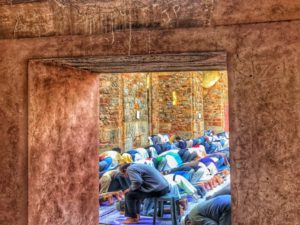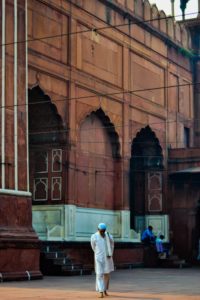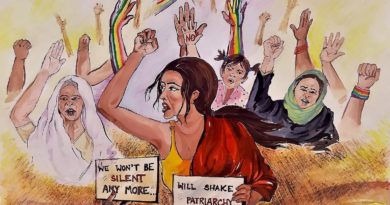Cultural dialogue: Tracing Yemeni Ancestry through a Pazheri Identity
The beauty of every civilization throughout the annals of history, is distinctly characterised by the social interactions which it witnesses . History is shaped through such cultural interactions, which enhance the growth of historical intellect and consciousness.  The establishment of commercial contacts with the Arabian Peninsula bequeathed a legacy of rich cultural heritage, remnants of which are prominently visible in the culture and traditions of Kerala. Arshed Aziz Pazheri, a boy in his late teens, belongs to the quaint Kumaramangalam countryside, in Thodupuzha town, Idukki District. As we take a brief stroll of the countryside, he narrates with immense pride, his rich Yemeni ancestry and his close association with the historical forces of cultural interactions which shaped much of Kerala’s legacy of heritage.
The establishment of commercial contacts with the Arabian Peninsula bequeathed a legacy of rich cultural heritage, remnants of which are prominently visible in the culture and traditions of Kerala. Arshed Aziz Pazheri, a boy in his late teens, belongs to the quaint Kumaramangalam countryside, in Thodupuzha town, Idukki District. As we take a brief stroll of the countryside, he narrates with immense pride, his rich Yemeni ancestry and his close association with the historical forces of cultural interactions which shaped much of Kerala’s legacy of heritage.
The conversation starts, as he confirms the existence of a written Pazheri history by Abbas Master, a government-school principal and a revered Pazheri localite. Zainuddin Makhdoom II, a widely-known polymath of the Malabar, is widely considered to be the first person to have written an account of Kerala’s history. The title of his masterpiece, which literally translates as ‘Presentation for warriors on some news related to the Portuguese’, was a seminal work on the history of Muslims in Kerala, with special reference to the brutalities of the Portuguese invasion, which quite interestingly espouses the idea of Kerala nationalism. The Pazheris mostly reside in the Malappuram and Idukki districts of Kerala. Pazheri is the name of a famous and powerful peasant tribe having its roots in Yemen’s Hadhramaut region.
One of the most famous origins of the Arab influx which led to an Arabic-Malayali cultural synthesis has been argued on the points of view of the spread of Islam in the Malabar. The origin of the Cheruman Perumal myths, led to the widespread belief and a local legend that he witnessed the splitting of the Moon, a miracle performed by Prophet Muhammad, and his further journey to meet The Prophet, which eventually resulted in his conversion to Islam, by adopting the name Tajuddin and thus, he was the first Islamic convert of the subcontinent. The mystery of his disappearance on the return journey, also gave rise to the belief that he died in Salalah, in present-day Oman or Zafar, a historic site, in present-day Yemen and the people who had accompanied him came to Kodungallur, in the present-day Thrissur district of Kerala and settled there. A parallel belief is that a group of Arabs led by Malik bin Deenar, widely considered to be the first known Muslim to have come to India in order to propagate Islam, established mosques, nearly around AD 642, during the time of Khalifa Umar of the Rashidun Caliphate. It is now widely accepted that he died at Kasaragod, Kerala and his relics are buried at the historic Malik Deenar Juma Masjid.
After the Islamic influx into the subcontinent, there were repeated cultural exchanges which led to the settling of various peasant tribes, such as the Pazheris themselves. As Arshed reflects upon his own personal account, he makes a notable mention of Pazheri Hussain Valliyupuppa who migrated from Yemen in 1014 AD. ‘Valliyupuppa’ roughly translates into great-grandfather and the title has been bestowed upon Hussain, by the Pazheri localites, as a mark of reverence for their ancestor. The Pazheri community has set its foot on other parts of the world, as well, and with slight variations in the name, such as ‘Basheri’ (distinct from the nomadic Persian tribe Basseri), the Pazheris are also to be found in Europe and America. Hussain came and resided at a place in Malabar, along with a revered Sufi Shaikh or Pir Fariduddin Aulia. They came to the regional kingdom of Keezhmalainadu, with its capital at Karikodu, in the Malabar, in present-day Thodupuzha. Hussain was a famous physician, as well, and was the royal physician of the King of Keezhmalainadu. Quite contented with his services, the King donated place for establishing a Masjid, which is now known as the Darul Huda Masjid, or Valiyaveetil Masjid, according to the local dialect, which means ‘a big house/family’. It is almost 900 years old, and has stood the tests of time, being one of the oldest Masjids of Thodupuzha.
Arshed narrates that he belongs to the lineage of Pazheri Hussain Valliyupuppa, as all other Pazheris similarily consider themselves to be, and further claims that Pazheri Hussain had many sons, amongst which Pazheri Beeran Sahib was the most famous, and the 5 sons of Pazheri Beeran Sahib, are the ancestors of the Kerala’s Pazheri community. Of these 5 sons, Makkar Sahib settled at Thodupuzha, and the place where he settled is known as Pazheri nowadays. The rest of Pazheri Beeran Sahib’s sons settled in the modern-day districts of Malappuram, Kasaragod and Kannur. The Pazheri community has historically, been adherents of the Qadiri Silsila, holding Khwaja Mohiuddin Abdul Qadir Gilani n great reverence. They built a Masjid in Thodupuzha, naming it as the Pazheri Muhiuddin Juma Masjid, and out of further respect, a son in every Pazheri family of Thodupuzha is interestingly, named as Mohiuddin, or with its local variations. Arshed points out that a maxim used to do the rounds in the olden times at Thodupuzha that “Islam, Muslim, Pazheri, Masjid”, which signified that whenever there was a problem in Islam and its interpretations, the Pazheri family had the last word in Thodupuzha. 
Many Yemeni Pazheris settled in Thodupuzha due to the stark similarity in the topographical profile and general geographical conditions. Yemen, despite being in the Arabian peninsula, differs remarkably from the desert conditions of regions like Saudi Arabia, and was historically quite rich in the agrarian sector, with people adopting techniques of irrigation and agriculture flourished on an unprecedented scale. Similar geographical conditions existed in what is present-day Eranad in the Malappuram District and Thodupuzha in the Idukki District, which cultivate the similar types of crops. Malappuram, also being a centre of the Pazheris, is an important place, as far as their history is concerned. Malappuram’s history has been deep-rooted in colonial uprisings and brave resistances against the British Empire. It is a developing province, which is remarkably famous for its religious harmony. The Pazheri communities, with peasantry as a chief occupation, contributed towards the fame of Thodupuzha in agriculture, with coconuts, areca nuts, bananas, and tapiocas being the most widely-cultivated crops. Thodupuzha was also famous for its black pepper. The Pazheri families followed the main agricultural system with land cultivation during the Meenam and Metam months of the Malayalam calendar. Arshed points out another interesting detail that a specific rice type was widely cultivated by the Pazheris, known as Pazhavari, and speculations are that the origin of the name of the rice type lies in the name of the Pazheri communities which cultivated it.
There have been conscious attempts to document the Pazheri history. An archaeological collection exists at the house of Pazheri Hajiar Ali, which includes a vast collection of the old objects used and ornaments of girls. Many state-level family meets have been held by the Pazheris and in one such meet, it was expected that around 10,000 people would turn up, and still a decent 4,000 – 5,000 showed up, quite enthusiastically. With the societal transformation, the extended Pazheri families took up other professions, as well, in the 20th century, and made rapid advances in numerous fields, diverting from their mainstream occupation of peasantry.
Arshad narrates the myth of a famous Maravetti tree at the Valiyaveetil Juma Masjid at Vengalloor, Thodupuzha. Some Pulayar (an ancient, untouchable caste) women came to the tree, to cut it down and obtain wood. They suddenly felt immense, and unbearable body pain. After a little while, they heard the sound of certain holy spells and repititive Zikr, and this astonishing feat caught the attention of the people around, who gathered around the tree, performed rituals, believing that it was a sacred tree, read the Quran and immediately, their body pain vanished. The Maravetti tree is believed to be one of the oldest trees of Keezhmalainadu.
As the sun sets upon the ‘Land of Wonders’, leaving a beautiful orangish tinge in the dusky sky, Arshed gleefully states his belief that the Maravetti tree stands there, just as his ancestor, Pazheri Hussain Valliyupuppa, the great-grandfather, looking upon his descendants, with utter contentment of the civilizations of time and heritage shaped through cultural interactions, leaving an indelible impression upon what he always considered as his homeland. . .
Author: Somnath Pati



Hey, you used to write fantastic, but the last several posts have been kinda boring¡K I miss your tremendous writings. Past several posts are just a little out of track! come on!
Hello our source. We’re sorry that you’re facing this issue, but we assure you that we have a dedicated team of content writers and editors who work day and night to give you the best of the content but we’d definitely keep this in mind the next time before publishing an article. We really appreciate your criticism. stay tuned!